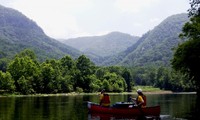Imagine a time without paved roads, railways or internal combustion engines. A time early in our nation’s history when the land was wild, and rivers - not interstates -provided the most expeditious means of exploration and commerce. Such was the climate in the early 1770′s when Anthony Rucker, a prominent farmer in Amherst, Virginia, developed the James River Batteau. Every year the James River Batteau Festival commemorates the batteau with an 8-day expedition.
Rucker developed the long, narrow, flat-bottomed cargo vessel (between 40-60 ft long and 6-8 ft wide) as a means of safely transporting his crops down the shallow James to Richmond. Within a few years the boat was in widespread use along rivers through the Southeast.
More than a decade prior to Rucker's boat development, a young George Washington got his first taste of the Ohio River Valley during the French and Indian War. This experience inspired a vision for establishing reliable commercial routes across Virginia. Washington envisioned the utilization of rivers as connective routes from the Chesapeake, through the Piedmont, across the rugged Appalachians, and into the fertile Ohio River Valley. In 1774 he wrote, "smooth the road, and make easy the way, and see how amazingly our exports will be increased, and how amply we shall be compensated for the expense of affecting it."
Washington's vision for cementing commercial routes was shared by federalist and anti-federalists alike, including U.S. Supreme Court Chief Justice John Marshall. At the request of the Virginia General Assembly in 1812, 56-year old Marshall led a group of commissioners on a journey to discern the feasibility of navigational improvements between Lynchburg, Virginia and the Great Falls of the Kanawah. A reliable commercial route to the Kanawah would open trade with the Ohio River Valley and ultimately access to the Mississippi. They departed Lynchburg September 1, 1812.
The 250-mile expedition, into present day West Virginia, carried significant risk. Marshall and a crew of boatmen ascended the James from Lynchburg, up the Jackson to Covington, and carted the boat over the Alleghenies. With very little knowledge of what lay ahead of them, they descended the Greenbriar into the New and ran the New to its confluence with the Gauley where it forms the Kanawha. Today the New River is home to a thriving commercial whitewater industry. Marshall, seeing it from the bow of a batteau wrote, "The New River … having to search its intricate way through a long chain of lofty and ragged mountains, whose feet it washes, exhibits an almost continued succession of shoals and falls, from which the navigator is sometimes, though rarely, relieved by a fine sheet of deep placid water."
Having reached the Great Falls of The Kanawha on October 9, 1812, the commissioners returned home overland. Upon returning, Marshall delivered a detailed report to Governor Barbour on the rivers navigated and was decidedly enthusiastic about opening the route for trade. Marshall's courage in undertaking such a journey is a testament to the determination of our founders to affect commercial development, prosperity and political unity.
Batteau navigation between Richmond and Lynchburg was already the primary means of transportation between the two cities, and the James River Company had been planning a canal along the route. Marshall's survey encouraged The James River Company to begin digging a canal with aspirations beyond Lynchburg. In 1832, this company became the James River and Kanawha Company, whose stated mission was to realize Marshall's vision. The canal was never completed due to funding issues and the development of railroads whose construction and transportation proved much more efficient than the canal. However, the path Marshall laid out remains a means of penetrating the rough Appalachian frontier. CSX, US Route 60 and Interstate 64 all follow the same general corridor.
Read more at http://www.vacanals.org/batteau/
Comment
You Might Also Like
James River State Park
James River State Park is most notable for its tremendous views and excellent access to the James River. The 1440-acre Park is one of the newest in the state and boasts three miles of James River frontage. What few Virginians probably realize …
River Trip: The Upper James Water Trail
From the James River's beginning at the confluence of the Jackson and Cowpasture Rivers and following its dramatically beautiful path through the Allegheny Mountains, is the Upper James River Water Trail, a Botetourt County project that invites …
Lynchburg: The City of Seven Hills
A major trading and manufacturing center from Colonial times through the Civil War, and a favored location of Thomas Jefferson, Lynchburg played an important role in the history of Virginia and the James River.
James River and Kanawha Canal
An ambitious project that George Washington proposed as a young man surveying the mountains of western Virginia, the Canal succeeded in linking the Piedmont and Tidewater regions. It was a driver of economic growth for Virginia, but was ultimately …

















